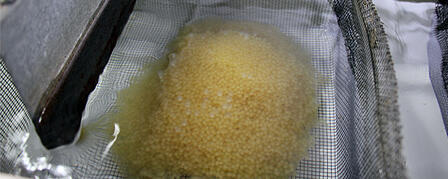PRATT HATCHERY PROVIDES SAFE HAVEN FOR MILLIONS OF CHANNEL CAT EGGS

June 12, 2014
A hatchery settingkeeps natural predators, bacteria and fungus away from eggs
PRATT– Seventy-four degrees Fahrenheit is the perfect water temperature – when it comes to artificial channel catfish spawning, that is. Each year, staff at the Kansas Department of Wildlife, Parks and Tourism (KDWPT) Pratt hatchery conduct an artificial spawning program that produces channel catfish eggs in the millions. It’s a process that’s tried and true, and that thousands of anglers depend on each year. Here’s how it’s done.
The process begins in early spring when hatchery staff prepare several ponds with an ideal breeding ratio – 2 males for every three females. When summer hits, staff submerge steel cream cans in knee-deep water to simulate a natural cavity where catfish would normally nest. Once the cans are fully submerged, a male will enter and prepare a nest site and then herd a ready-to-spawn female into the can where eggs are deposited and fertilization can begin. When waters reach the ideal temperature of 74 degrees, hatchery staff will check the cans twice a week and collect any fertilized egg masses, which can average 1.5 to 2 pounds each.
“The purpose of this process is to increase hatch rates. On our first day of collection, we got 908,000 eggs – 80 percent of which we can get to hatch in a controlled environment,” said KDWPT fisheries biologist Brett Houdyshell. “Our goal this year is to collect approximately 3 million eggs.”
Once the fertilized eggs are collected, they are placed in special troughs with constant water circulation where the young can safely hatch. After about eight days, the fry are able to swim up and out of the egg mass and into connected tanks where food is available.
“Channel catfish readily take fish food, so by their eighth day, they will be eating a prepared fish food,” said Houdyshell.
Some fry will grow to fingerlings where they will be stocked in new or renovated waters, while others will stay in the hatchery system where they will continue to grow and be stocked the following fall as intermediate or catchable-size fish, ranging from 10-12 inches.
Channel catfish are just one of many fish species that KDWPT hatchery staff produce around the state. For more information on KDWPT fish hatcheries and stocking reports, visit ksoutdoors.com and click “Fishing.”
-30-









